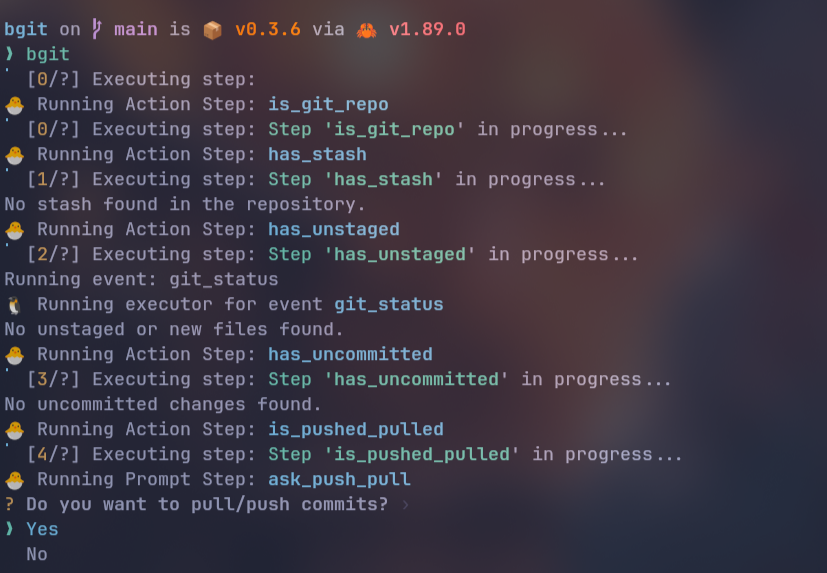Introducing bgit: One Command for Most of git
Let's be honest: we've all felt that flash of panic before hitting enter on a Git command. Is this going to work, or am I about to break everything? Git is essential, but it shouldn't be terrifying. I built a tool to act as a friendly guide, inspired by the exact moments of confusion I saw while mentoring at a college hackathon.
Let's Talk About Git Fumbles
Last year, I was an unofficial mentor at HackOFiesta, our college's annual hackathon. My main job was helping folks with git. I saw it all: from git push with no internet connection to the classic "I pushed the entire node_modules directory to GitHub."
Many of these problems were simple mistakes, but they all pointed to a common theme: a fragile workflow. Most participants were new to version control. For them, the Git universe was a three-command loop: git add, git commit, git push. Anything beyond that, and they'd often turn to a UI, missing out on the power of the command line.
This experience sparked the idea for bgit. I wanted to build a tool that was simple, intuitive, and smart, yet configurable enough to grow with the user. I didn't want to create just yet another shell script wrapper, those are hard to test and maintain.
Instead, bgit became a framework built around rules, events, and workflows. The goal? A tool with almost no learning curve. A tool that's easy, and dare I say, fun to use.
A Quick Word on Git

Before we dive into bgit, let's quickly cover what Git is. In short, Git is a Version Control System (VCS).
Think of it like a super-powered time machine for your code. It takes "snapshots" (called commits) of your entire project at different points in time. If you make a mistake, you can easily rewind to a previous version.
It also makes it possible for many people to work on the same project without overwriting each other's changes. It’s the standard tool used by developers worldwide, but its power comes with a steep learning curve. This is the exact problem bgit is designed to solve.
What is bgit?
bgit is a command-line tool, written in Rust, that simplifies the Git workflow for beginners.
If you're already a Git power user, this tool might not be for you, and that's okay! bgit is designed for the student, the new developer, or anyone who just wants to get their "hello world" website on GitHub without falling down the rabbit hole of advanced version control concepts. It aims to be a better first step than the "Add files to upload" button on the GitHub website.
Instead of requiring you to memorize subcommands, you just run bgit. It intelligently detects the state of your repository's staged files, uncommitted changes, stashes, and guides you with simple prompts.
Getting Started: Installation
Let's get it installed. It's a single command.
Linux/macOS
bashcurl -fsSL https://raw.githubusercontent.com/rootCircle/bgit/main/scripts/install.sh | bashWindows (PowerShell)
powershelliwr -useb https://raw.githubusercontent.com/rootCircle/bgit/main/scripts/install.ps1 | iex
How to Use bgit (and its Goodness)

Using bgit is as simple as typing the command in your terminal:
bgitThat's it, no complex subcommands or weird flags. From there, bgit works by asking you simple questions. It uses "yes/no" prompts, multiple-choice questions, and occasional text inputs to guide your workflow. Want to commit, but have unstaged files? bgit will ask you what to do with them. Accidentally staging a secret .env file? bgit will catch it.
The power remains with you, but the process is safer and heavily focused on best practices.
The bgit Philosophy: Simplicity over Configurability
Git is incredibly powerful, but its endless flexibility can be a curse for beginners. The fear of running the wrong command can be paralyzing. While this configurability is a blessing for power users, it also opens extra leg room for stupidity for those less experienced, including me. On the other hand, too little configurability can make the tool rigid and unsuitable for diverse needs.
bgit takes a strong stance here: it intentionally limits configuration to create a straightforward, safe path. We handle the "great responsibility" so you can focus on your code.
However, for those who need it, bgit offers two levels of configuration:
- Global: Located at
~/.config/bgit/config.tomlfor user-wide settings (like auth keys). - Repo: Located in your project's
.bgit/config.tomlfor repo-specific rules.
bgit's config.toml: Configuration When You Really Need It
By default, bgit is a "zero-config" tool. It's designed to work out of the box with sensible, safe defaults to protect beginners. However, for those who need more control, bgit offers a simple and powerful configuration system.
The most important rule is that global and local settings are completely separate and non-overlapping.
Global Config (
~/.config/bgit/config.toml): This file is exclusively for your personal, user-specific settings that apply across all projects. Think of authentication, API keys, and other personal preferences.Example Global
config.toml:toml[auth] preferred = "ssh" [auth.ssh] key_file = "/home/user/.ssh/id_ed25519" [integrations] google_api_key = "your_google_api_key_base64_encoded"Repo Config (
.bgit/config.toml): This file lives in the root of your project and contains rules for that specific repository. It’s perfect for enforcing team-wide standards.Example Local
config.toml:toml# Rules configuration [rules.default] IsGitInstalledLocally = "Error" GitNameEmailSetup = "Error" NoSecretsStaged = "Error" # Prevent committing secrets! # Workflow configurations [workflow.default.is_sole_contributor] overrideCheckForAuthors = ["testuser@email.com"]
A setting designed for the global file will not work in the local file, and vice versa. Because of this strict separation, one file cannot override the other; they simply manage completely different sets of options. This design prevents confusion and makes a project's behavior explicit and predictable.
This two-level system gives you the best of both worlds: a zero-config experience by default, with the option to set powerful rules for yourself for your team.
The bgit Hook System
If you've used Git for a while, you might know about its hook system, scripts that run at certain points in the workflow. It's a great idea, but with a major flaw: the hooks live in your local .git/hooks directory. They aren't version controlled, so you can't share them with your team, making consistent automation a challenge.
With bgit, hooks are verion controlled. While bgit doesn't support standard Git hooks completely yet, it has its own powerful event-driven system called hook_executor.
The bgit hook system is much more versatile than standard Git's, covering events across the entire development lifecycle. You can automate tasks for almost any action, from the moment you clone a repository to when you pop a stash, and everything in between.
The system is also far more versatile than Git's, letting you automate everything from cloning a repo to popping a stash. Just add an executable script—be it shell, PowerShell, or a .exe—to the .bgit/hooks/ directory, following a simple [pre|post]_[event_name] pattern.
This is powerful, but one hook, in particular, changes the game: post_git_clone.
Imagine cloning a complex project. Instead of a long list of setup instructions in the README, the maintainer can place a setup script at .bgit/hooks/post_git_clone. When you clone the repo using bgit, it automatically runs the setup script for you. One command to clone and set up an entire development environment.
We successfully demonstrated this concept in our rootCircle/bgit_clone_sample repository.
Smart Guardrails: The bgit Rule System
NOTE
Stupidity can be broadly categorized into:
- Accidental Stupidity
- Stupidity out of covenience
- Complete Stupidity ~ Walter Wallis (Programmers are also human)
While no tool can prevent every mistake, bgit certainly aims to reduce the risk associated with the first two
Remember the hackathon story about developers pushing node_modules or secret keys to GitHub? These common mistakes are exactly what the bgit rule system is designed to prevent.
Think of rules as a set of automatic safety checks that run before you take critical actions like committing your code. Instead of you having to remember a long checklist of best practices, bgit acts as a vigilant assistant, watching your back.
Here are a few of the built-in rules that protect you:
NoSecretsStaged: Scans for common secret files like.envor credential keys to prevent you from accidentally leaking sensitive information.NoLargeFile: Warns you if you try to commit a very large file that probably belongs in your.gitignore.GitNameEmailSetup: Checks that your Git username and email are configured correctly before you even make your first commit.
and many more...
What makes bgit's rules truly special is that they don't just tell you something is wrong—they can often fix the problem for you automatically. If a rule is broken, bgit might offer to unstage the problematic file or help you configure your settings, turning a potential mistake into a learning moment.
For teams, the behavior of these rules can be configured in the project's .bgit/config.toml file, ensuring everyone on the project is protected by the same safety standards.
Conclusion
Git is the industry standard for version control, and learning it is a journey every developer should take. bgit isn't here to replace that journey. It's here to be a friendly first step—a set of training wheels that guides you with best practices until you're ready to ride on your own.
The project is fully open-source, distributed under the MIT license, and is currently in a pre-alpha stage. This is the perfect time to get involved, provide feedback, and help shape its future. bgit is built with Rust and supported on Windows, macOS, and Linux.
So, give it a try on your next project. Star the repository on GitHub if you find it interesting, and don't hesitate to open an issue with feedback or suggestions.
Happy coding, and may you never push node_modules again!
Acknowledgments
bgit would not have been possible without the immense contribution of Sidharth Singh. Special thanks also go to Himanshu and Gyandeep for their valuable contributions along the way.
Meta
- GitHub Repo: github.com/rootCircle/bgit
- Crates.io: crates.io/crates/bgit
- How bgit works
- bgit docs